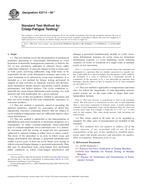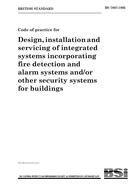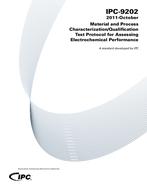
ASTM E2714-09e1
Original price was: $65.00.$39.00Current price is: $39.00.
Standard Test Method for Creep-Fatigue Testing
standard by ASTM International, 11/01/2009
1.1 This test method covers the determination of mechanical properties pertaining to creep-fatigue deformation or crack formation in nominally homogeneous materials, or both by the use of test specimens subjected to uniaxial forces under isothermal conditions. It concerns fatigue testing at strain rates or with cycles involving sufficiently long hold times to be responsible for the cyclic deformation response and cycles to crack formation to be affected by creep (and oxidation). It is intended as a test method for fatigue testing performed in support of such activities as materials research and development, mechanical design, process and quality control, product performance, and failure analysis. The cyclic conditions responsible for creep-fatigue deformation and cracking vary with material and with temperature for a given material.
1.2 The use of this test method is limited to specimens and does not cover testing of full-scale components, structures, or consumer products.
1.3 This test method is primarily aimed at providing the material properties required for assessment of defect-free engineering structures containing features that are subject to cyclic loading at temperatures that are sufficiently high to cause creep deformation.
1.4 This test method is applicable to the determination of deformation and crack formation or nucleation properties as a consequence of either constant-amplitude strain-controlled tests or constant-amplitude force-controlled tests. It is primarily concerned with the testing of round bar test specimens subjected to uniaxial loading in either force or strain control. The focus of the procedure is on tests in which creep and fatigue deformation and damage is generated simultaneously within a given cycle. It does not cover block cycle testing in which creep and fatigue damage is generated sequentially. Data that may be determined from creep-fatigue tests performed under conditions in which creep-fatigue deformation and damage is generated simultaneously include (a) cyclic stress- strain deformation response (b) cyclic creep (or relaxation) deformation response (c) cyclic hardening, cyclic softening response (d) cycles to formation of a single crack or multiple cracks in test specimens.
Note 1 – A crack is believed to have formed when it has nucleated and propagated in a specimen that was initially uncracked to a specific size that is detectable by a stated technique. For the purpose of this standard, the formation of a crack is evidenced by a measurable increase in compliance of the specimen or by a size detectable by potential drop technique. Specific details of how to measure cycles to crack formation are described in 9.5.1.
1.5 This test method is applicable to temperatures and strain rates for which the magnitudes of time-dependent inelastic strains (creep) are on the same order or larger than time-independent inelastic
Note 2 – The term inelastic is used herein to refer to all nonelastic strains. The term plastic is used herein to refer only to time dependant (that is, non-creep) component of inelastic strain. A useful engineering estimate of time-independent strain can be obtained when the strain rate exceeds some value. For example, a strain rate of 1×10-3 sec-1 is often used for this purpose. This value should increase with increasing test measurement.
1.6 The values stated in SI units are to be regarded as standard. No other units of measurement are included in this standard.
1.7 This standard does not purport to address all of the safety concerns, if any, associated with its use. It is the responsibility of the user of this standard to establish appropriate safety and health practices and determine the applicability of regulatory limitations prior to use.
Product Details
- Published:
- 11/01/2009
- Number of Pages:
- 14
- File Size:
- 1 file , 490 KB
- Note:
- This product is unavailable in Russia, Ukraine, Belarus



